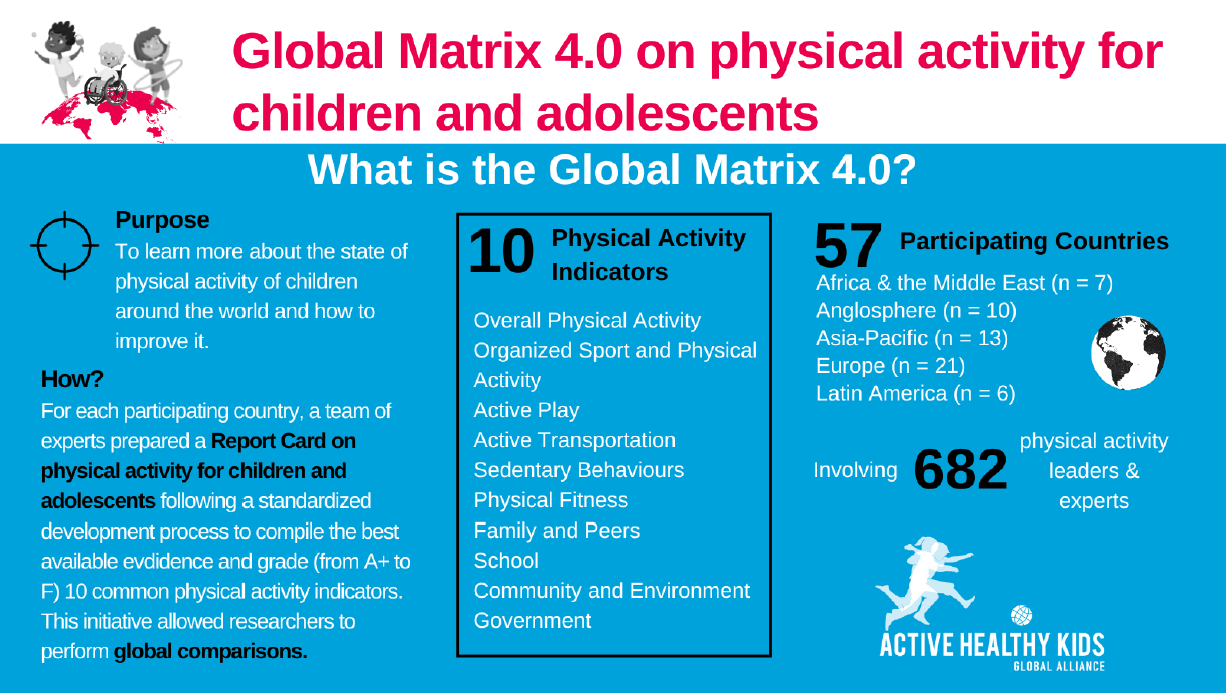
Children and adolescents around the world are not moving enough to promote healthy growth and development, and the COVID-19 pandemic only made matters worse, a new global report has found.
The Global Matrix 4.0 report by the Active Healthy Kids Global Alliance (AHKGA) follows the recent publication of the Ireland North and South Report Card on Physical Activity for Children and Adolescents, which found that not all children and teens in Ireland and Northern Ireland had an equal chance to be active.
The Ireland North and South Report awarded a C minus grade for overall physical activity in children and teens across the whole island, representing a slight improvement on the D grade awarded in 2016 but also identified a range of inequalities.
Under the global initiative all Report Cards are generated using a standardised grading system, with grades from A for succeeding with a large majority of children to F for succeeding with few children.
Today the Global Matrix 4.0 report reveals the findings from this global report series – comparing grades across 57 countries and representing the largest compilation of children’s and adolescents’ physical activity characteristics to date.
The global report found Denmark, Finland, Slovenia, and Japan among the countries that are leading the way in terms of physical activity levels among children and adolescents. Ireland and Northern Ireland ranked in 16th place for overall physical activity levels in the latest edition of the Global Matrix.
The report authors said that the initiative highlighted that the global situation regarding the physical activity of children and adolescents remains a “serious public health concern”.
The Global Matrix 4.0 report revealed that modern lifestyles – increases in digital screen time, the growing urbanisation of communities, and the rise in automation of previously manual tasks – are contributing to a pervasive yet unequally distributed public health problem that must be recognised as a global priority.
AHKGA President Professor Mark Tremblay said: “New habits have been formed by children and adolescents around the world in response to the new normal provoked by a socially accepted screen-centric indoor living society and exacerbated by the Covid-19 pandemic, global conflicts, and severe weather associated with climate change”.
“Without significant efforts to recalibrate the modern and pandemic-influenced lifestyle of our children and adolescents, we risk mortgaging their future health and well-being. We hope this report will be a call to action for societies around the world,” he added.
The AHKGA identified key priorities for action including:
- Increasing opportunities for being physically active at school, increasing the amount of physical education per week, and making physical education a compulsory subject for all school levels.
- Providing free access to public spaces, green space, playgrounds, sport facilities, and active transportation infrastructures, while addressing the issue of safety of the environment as a priority.
- Developing physical activity policies that provide more equitable, accessible, inclusive, flexible, and attractive sport program opportunities by specifically targeting girls, children and adolescents with a disability, from low-income families, and/or facing segregation or marginalisation, as well as adolescents to reduce the age-related physical activity decline.
- Physical activity policies and strategies require better implementation, monitoring, and evaluation. This includes providing regular evaluations of progress towards meeting the World Health Organization’s targets to reduce physical inactivity by 15% by 2030. Greater transparency and clearer accountability related to the implementation of policies is needed.
For more details about the overall global findings see this open access publication: Aubert S et al. Global Matrix 4.0 Physical Activity Report Card Grades for Children and Adolescents: Results and Analyses from 57 Countries. Journal of Physical Activity and Health. 2022.
Manuscripts published in the Journal of Physical Activity and Health:
- Active Healthy Kids Global Alliance Global Matrix 4.0 – a resource for physical activity researchers (https://doi.org/10.1123/JPAH.2022-0257)
- Global Matrix 4.0 Physical Activity Report Card Grades for Children and Adolescents: Results and Analyses from 57 Countries (https://doi.org/10.1123/JPAH.2022-0456)
- Recent secular trends in child and adolescent physical activity and sedentary behaviour internationally: analyses of data from Active Healthy Kids Global Alliance Global Matrices 1.0-4.0 (https://doi.org/10.1123/JPAH.2022-0312)
- Association between physical activity indicators and Human Development Index at the national level: Information from the Global Matrix 4.0 Physical Activity Report Cards for Children and Adolescents (https://doi.org/10.1123/JPAH.2022-0321)
- Economic freedom, climate culpability, and physical activity indicators among children and adolescents: Report Card grades from the Global Matrix 4.0 (https://doi.org/10.1123/JPAH.2022-0342)
- Promoting Physical Activity among Children and Adolescents with Disabilities: The Translation of Policy to Practice Internationally (https://doi.org/10.1123/JPAH.2022-0351)
Complete details of the Global Matrix 4.0, each country’s leaders, grades, report cards, are available at www.activehealthykids.org.
